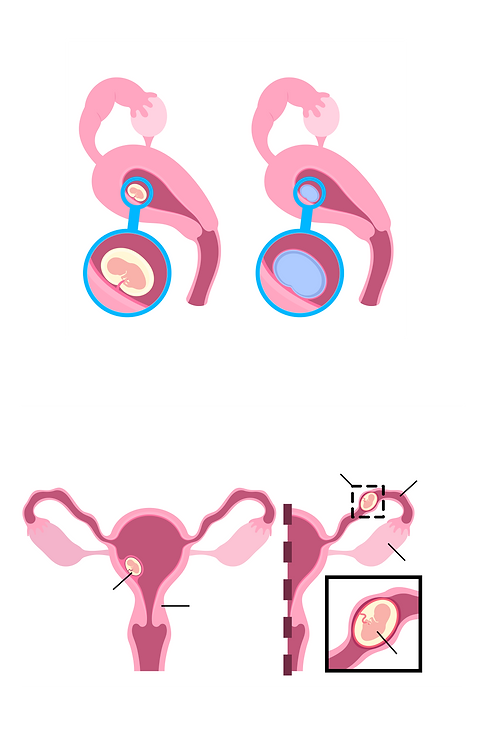
I am planning my pregnancy
Ovulation

MONITORING
Length of your cycles in days

length of your
cycles (days)
set your monitoring start
date according to your
menstrual cycle*
start monitoring 17 days
before your expect
next period
* count the 1st day of your period as the start day / ** in this case, if you have less than 21 days in your cycle, the first day of monitoring will be the 5th day.
For non-standard cycles of less than 25 days or more than 30 days, we recommend using the 7-day kit followed by 15 tests if the 7-day result is negative.
Target the ideal period for fertilization

As mentioned on the previous page, the menstrual cycle is divided into three distinct phases.
During the ovulatory phase, the levels of luteinizing hormone (LH) and follicle-stimulating hormone (FSH) gradually increase. LH triggers the release of the egg (ovulation), typically occurring 16 to 32 hours after the hormonal peak begins. Although estrogen levels initially decrease during this peak, this drop is relative to their peak levels that stimulate the LH surge, and they do rise again post-ovulation, in tandem with an increase in progesterone levels.
The rise in LH, which can be tracked until it reaches its peak, marks the moment of ovulation. By utilizing an LH test, individuals aiming for conception can better time their sexual activity to align with this fertile window.
Given that sperm can live for approximately 72 to 120 hours, it is advisable to monitor the progression of the ovulatory phase for at least 7 days by performing an ovulation test daily at the same time.
Unlike other tests, the first morning urine is often too concentrated, especially after a long sleep.
After the first morning urine, reduce your liquid intake and wait 2 hours before taking the ovulation test.
PRIMEVIEW digital ovulation test comes in the form of a refill of 7 and 15 tests.
PRIMEVIEW digital ovulation test also comes in COMBO form combining pregnancy tests and ovulation tests.
How does an ovulation test work?
Start counting on the first day of your period, then stop on the first day of your next one. Take an average if the length varies slightly from month to month. Next, determine when the first test will be performed. It is generally recommended to subtract 16 to 18 days from the cycle length.
When you have determined the day of your first analysis, perform the test at least 7 consecutive days, at the same time. If you fail, a longer option is available with a 15-test kit.
With PRIMEVIEW digital "ovulation test" result is represented on your monitor window by LH- during the presence of the hormone and LH+ when the peak is reached.
When to do an ovulation test
How many times ?
the first one
times
It may not be that easy to use an appropriate test to plan a pregnancy because there are many criteria to take into consideration.
several
attempts
are not rare
The desire to achieve this is certainly decisive in this choice.
With PRIMEVIEW digital ovulation test, we offer you a faster, more precise and certainly safer alternative.
desire and
there
planning
of a pregnancy
are the best assets for success
When desire and will are present notwithstanding certain physiolo-gical and pathological considera-tions, anything is possible.
Do not hesitate to share your experiences and your way of doing things with other women using our blog, a platform made available to you on this site.
To do this, subscribe.

Which method to choose
in this context, we will not only talk about ovulation tests but also methods
The desire to procreate and having difficulty doing so and/or planning a pregnancy are not new.
Many methods could be used or were applied not so long ago.
There is the measurement of basal temperature; analysis of cervical mucus (Billings method); the inspection of saliva under a microscope and others which combine one or the other.
specific monoclonal tests
Since the introduction of monoclonal tests in the 1990s, things have become simpler. Because this method makes it possible to highlight the specific hormones of women which vary in quantity throughout the menstrual cycle.
technology
to the aid of medicine
technology at home
Analysis technology associated with other fields such as optics and electronics has enabled considerable advances in medicine.
Understanding and observation have also progressed thanks to technology.
All these factors mean that Lagap SA can offer you high reliability, practical and safe tests.
Confirm a pregnancy

Abnormal pregnancies

ANEMBRYONAL PREGNANCY
normal pregnancy
non-viable egg
EXTRAUTERINE PREGNANCY (ectopic)
implantation of the fertilized egg
in the fallopian tube
fallopian tube
ovary
uterus
implantation
of the fertilized egg
normal pregnancy
ectopic pregnancy
The first steps to
confirming a pregnancy

In women with a regular menstrual cycle, which usually occurs every 21 to 28 days, ovulation takes place when one of the ovaries releases an ovocyte, or sex cell. This ovocyte leaves the ovary and migrates towards the Fallopian tubes, the conduit leading to the uterus.
If a woman has unprotected sexual intercourse around the time of ovulation, without using contraception, there is a risk of fertilization. A sperm can then penetrate the ovocyte, fertilizing it and thus forming a fertilized ovum.
About 6 to 10 days after fertilization, the ovum reaches the uterus and begins to implant in the endometrium, the mucous layer of the uterus. At this stage, the ovum becomes a blastocyst. This implantation, called nidation, depends on the HCG (human chorionic gonadotropin) hormone, produced by the blastocyst, which can be detected by pregnancy tests.
The blastocyst progressively implants in the endometrium to access nutrients and oxygen provided by the blood vessels of the mucous layer. The HCG hormone, whose level doubles every two days, is measured in international units (IU), reflecting the sensitivity of a pregnancy test.
The blastocyst consists of two main parts: the inner part, which will develop into an embryo, and the outer part, which will form the placenta, essential for protecting and nourishing the embryo.
In rare cases, the blastocyst may implant outside the uterus, such as in a Fallopian tube or an ovary, leading to an ectopic pregnancy.
It also happens that nidation fails shortly after it begins, resulting in the expulsion of the ovum. Often, this is a case of an anembryonic pregnancy, which is one of the main causes of miscarriage in the first trimester, occurring in about 50% of early pregnancy losses.
This condition can exist without the woman realizing she was pregnant, and although the HCG hormone may still be detected, the pregnancy will not continue.
Take a pregnancy test
About section. Every site has a story and users want to discover yours. This space is ideal for introducing yourself and explaining what your site has to offer. Double-click here to add the info you want to share. You can tell about your professional journey. Showcase your core values, your commitment to customers and why you stand out from your competitors. Add a photo, gallery or video to drive more engagement.
Confirm - how
a few
physiological signs
The first observation is certainly the absence of menstruation. At the same time or quite quickly certain signs such as changes in sense of smell, vomiting, headaches, severe fatigue are warning signs and are quite common at the start of pregnancy.
the pregnancy test
urinary
When unprotected intercourse has occurred and doubt persists, an early pregnancy test could be performed approximately 4 to 5 days before the expected period.
But in general, the ideal would be to perform a urine pregnancy test 1 to 2 days after the day of the expected period and this in the first urine of the morning (the most concentrated).
ultrasound
the pregnancy test
blood
If you prefer to have confirmation from a specialist, they will suggest that you do a classic urine pregnancy test or a blood test.
Ultrasound allows even more precise confirmation from the 4th week of pregnancy.
Which test to choose
the classic urine test
In all cases, a pregnancy test uses the same detection principle with varying degrees of reliability. The test itself is rarely questioned. Rather, it is the way of doing it and the reading that can create problems and bring certain uncertainties.

the digital test
The digital test is designed to chemically detect pregnancy but with an optical reading system more suited than the human eye for detecting hormonal presence in small quantities. The optical results are electronically confirmed by a sign that appears on the small screen of the monitor. Additionally, some digital tests provide, with sufficient accuracy, a signal indicating the number of weeks of pregnancy.
the blood test
The blood test, generally carried out in a laboratory, provides maximum certainty especially when implantation is abnormal or the quantities of HCG are extremely low or too high (when a pregnancy is very advanced) and thus difficult detectable with a urine test.
I'm pregnant What to do ?
In all cases a medical examination is necessary.
All essential measures to promote an optimal pregnancy are required.
In the event of an unwanted pregnancy, only the specialist can help you and give you the best advice!

I want my pregnancy
pregnancy
desired
A desired pregnancy is shared. It requires an ideal environment and many requirements will be put in place from the first days.
a planned pregnancy
A successful planned pregnancy is wonderful because all the preparations made beforehand have borne fruit.
A planned pregnancy also means having prepared your pregnancy down to the smallest detail, therefore less stress, less improvisation.

manage your pregnancy for 280 days
From this good news, you will have to manage your pregnancy for 9 months with all the physical and physiological changes that this entails.
More and more specialists are providing support and ideal solutions for this management, whether medical, economic, professional or health-related (a healthy lifestyle is a bonus for the future baby).
I hadn't planned
an unpredictable pregnancy
First of all, don't panic. We think, we consult, we find out.
If there is a pregnancy, only specialists can help you. All other measurements are incorrect.
But first of all, if you have done a urine pregnancy test (especially in a hurry or early), confirm the result with another test a few days later or consult your doctor.
Noticed: the morning after pill is no longer useful after implantation.
accept or refuse a pregnancy
It’s up to everyone to make their choice.
But this choice is not necessarily made alone. A psychologist specialized in this field, through his experience, will advise you best and support your decision. This last point is crucial because it will save you the bitterness of having made a bad decision.
A.B..R.
Induced abortion at the very beginning of pregnancy.
An abortion for medical reasons is called therapeutic abortion.
Voluntary termination of pregnancy, or abortion, is, as its name suggests, a woman's choice.
However, A.B.R. is subject to legislation which differs depending on the country, but falls within a precise framework (date of pregnancy, information, essential support).

